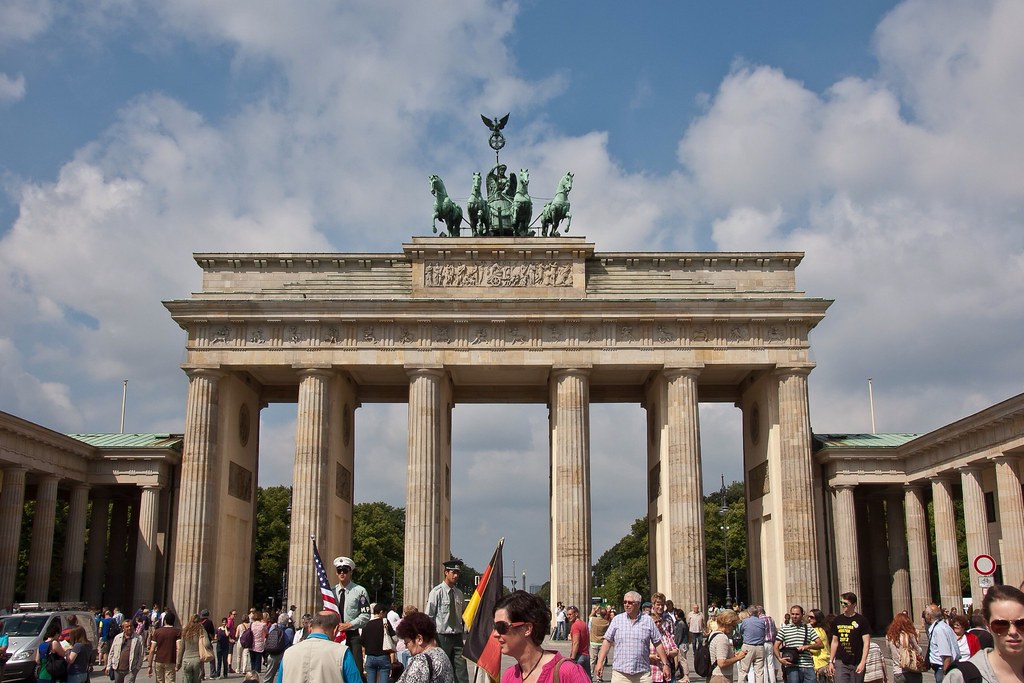
Above: The Brandenburg Gate.
Berlin has a population of 3.5 million people making it Germany's largest city and the second largest in Europe. First documented in the 13th century, Berlin was the capital of the Kingdom of Prussia (1701–1918), the German Empire (1871–1918), the Weimar Republic (1919–1933) and the Third Reich (1933–1945). After World War II, the city became divided into East Berlin and West Berlin(1961–1989). Following German reunification in 1990, the city regained its status as the capital of Germany.
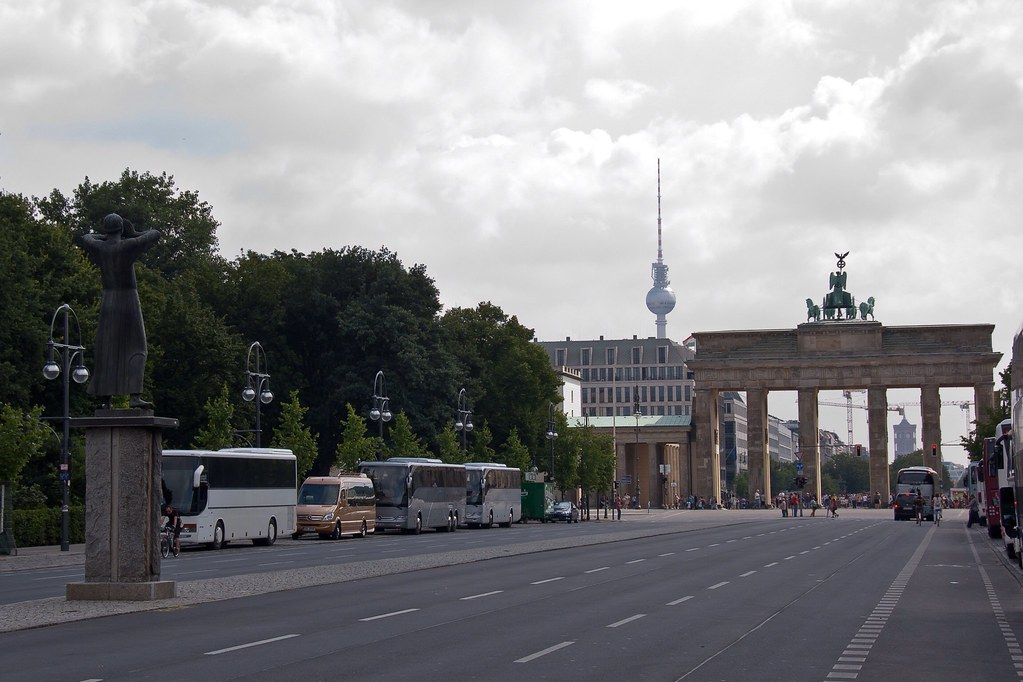
Above: The Brandenburg Gate with the monument to a soldier shouting across the Berlin Wall on the left and the famous Fernsehturm (TV tower measuring 368 metres and built in 1969) in the distance.
Our tour took us to many of the famous sights including the Brandenburg Gate (see above and below). The Gate is a former city gate, rebuilt in the late 18th century as a neoclassical triumphal arch, and now one of the most well-known landmarks of Berlin and Germany. Having suffered considerable damage in World War II, the Brandenburg Gate was fully restored in 2000. During the post-war Partition of Germany the gate was isolated and inaccessible immediately next to the Berlin Wall.
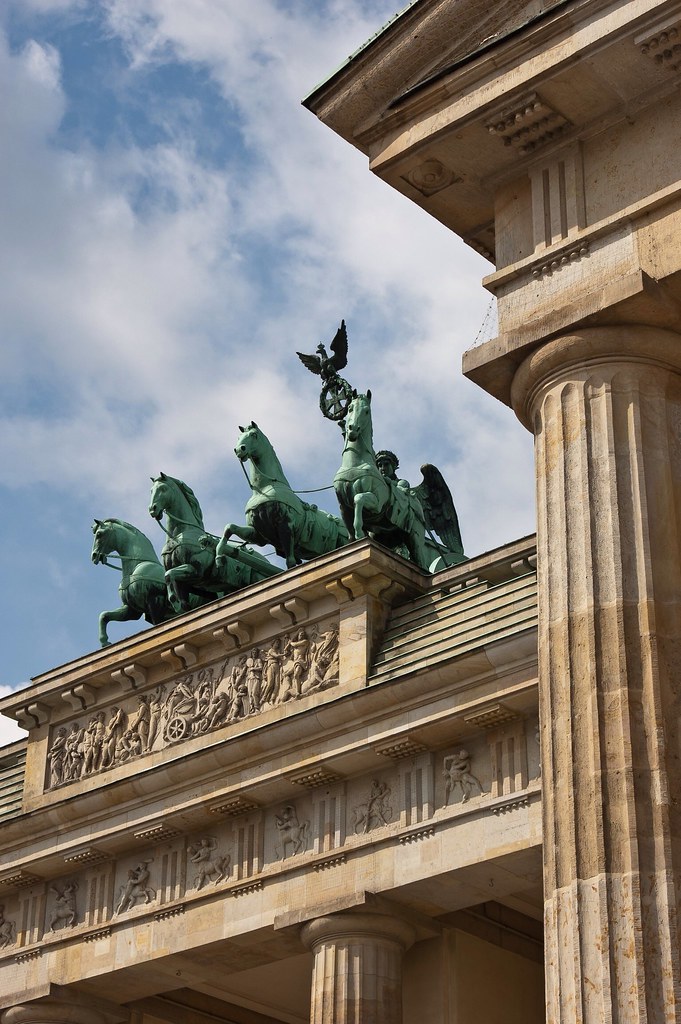
Above: A close-up of the Gate and the Quadriga, a chariot drawn by four horses driven by Victoria, the Roman goddess of victory.
Close by to the Brandenburg Gate is the Reichstag, the traditional seat of the German Parliament, renovated in the 1950s after severe World War II damage. The building was again remodelled by British architect Norman Foster in the 1990s and features a glass dome over the session area, which allows free public access to the parliamentary proceedings and magnificent views of the city.

Above: The Reichstag.
The 20th Century was a tumultuous time for Berlin and on our tour we saw and learned about some of the city's history. When Adolf Hitler and the Nazi Party came to power on 30 January 1933, Berlin's Jewish community began to be wiped out, with thousands of the city's Jews imprisoned in the nearby Sachsenhausen concentration camp following Kristallnacht in 1938. Later, in early 1943, many more were shipped to death camps, such as Auschwitz.
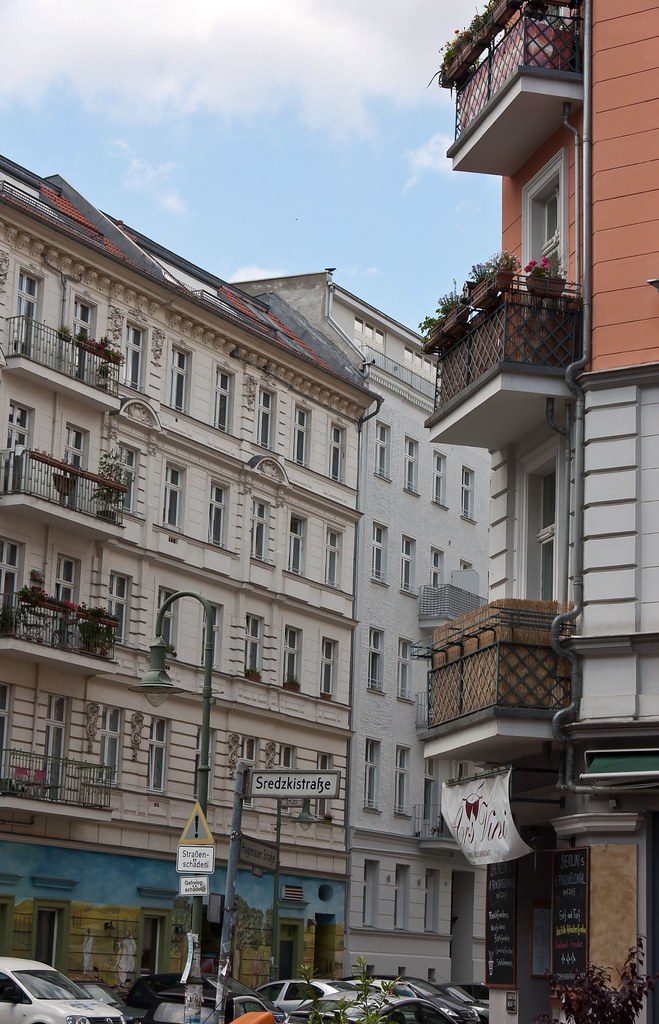
Above: A typical Berlin neighbourhood which we walked around.
During World War II, large parts of Berlin were destroyed in the 1943–45 air raids and during the Battle of Berlin. Among the hundreds of thousands who died during the Battle for Berlin, an estimated 125,000 were civilians. After the end of the war in Europe in 1945, the victorious powers divided the city into four sectors, analogous to the occupation zones into which Germany was divided. The sectors of the Western Allies (the United States, the United Kingdom and France) formed West Berlin, while the Soviet sector formed East Berlin.
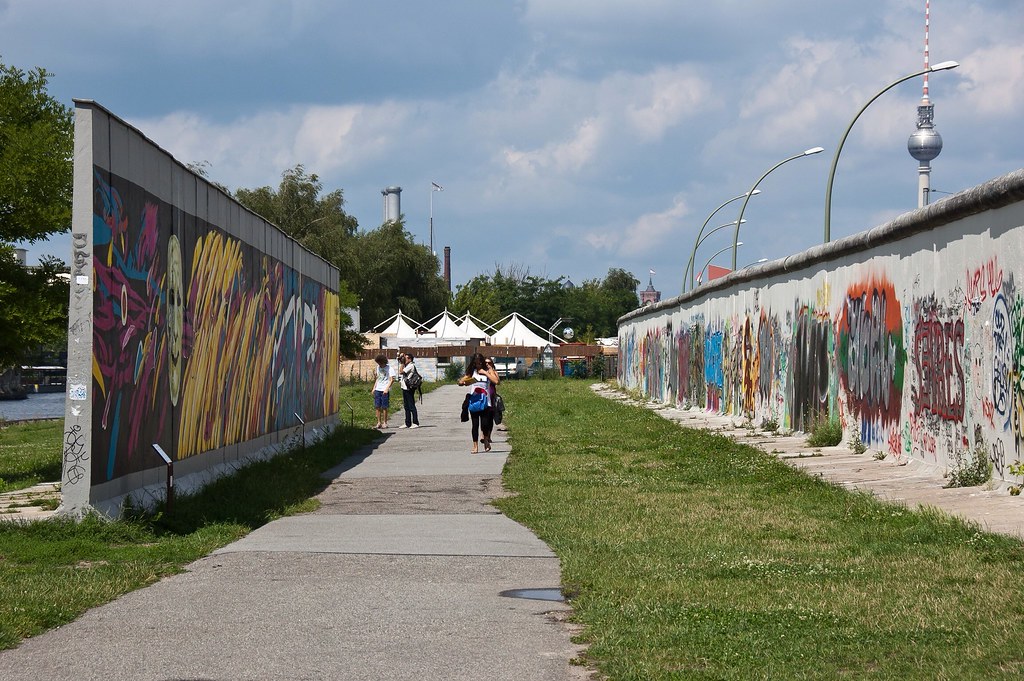
Above: The East Side Gallery is an open-air exhibition of art painted directly on the last existing portions of the Berlin Wall. It is the largest remaining evidence of the city's historical division.
As a result of the political and economical tensions brought on by the Cold War, on 13 August 1961, East Germany began building of the Berlin Wall between East and West Berlin and similar barriers around West Berlin, and events escalated to a tank standoff at Checkpoint Charlie on 27 October 1961. On our tour we stopped at Checkpoint Charlie which was the name given by the Western Allies to the best-known Berlin Wall crossing point between East Berlin and West Berlin during the Cold War.
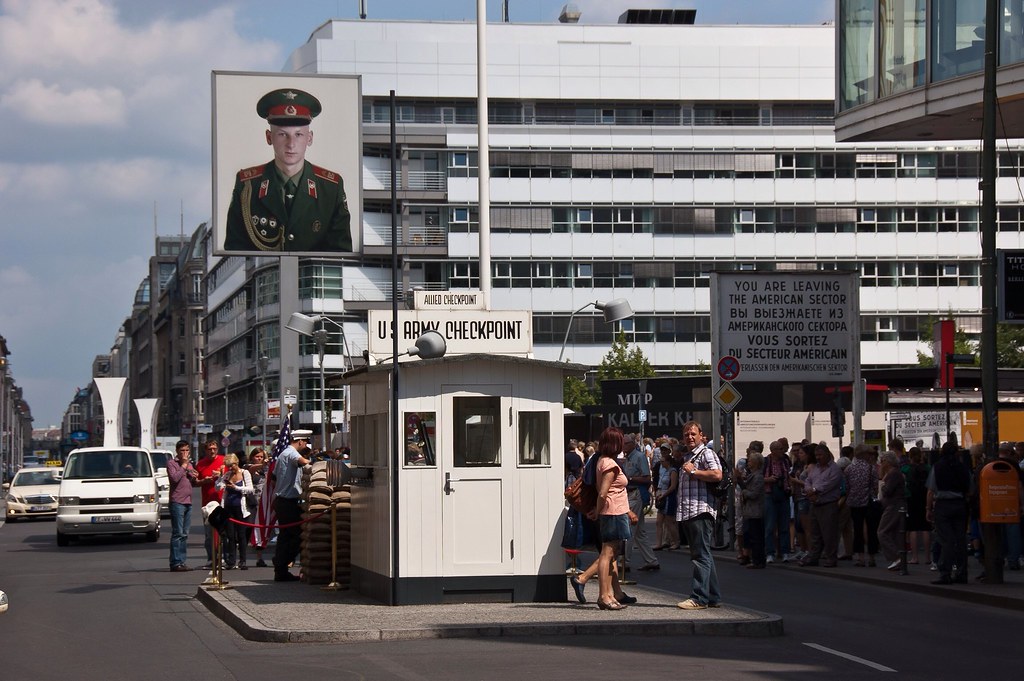
Above: A recreation of Checkpoint Charlie.
Berlin was completely divided. Although it was possible for Westerners to pass from one to the other (but only through strictly controlled checkpoints) for most Easterners, travel to West Berlin or West Germany was no longer possible.

Above: A single piece of the Berlin Wall, decorated with art.
In 1989, with the end of the Cold War and pressure from the East German population, the Berlin Wall fell on 9 November 1989 and was subsequently mostly demolished, with little of its physical structure remaining today. On 3 October 1990, the two parts of Germany were reunified as the Federal Republic of Germany, and Berlin again became the official German capital.
Kaiser Wilhelm Memorial Church was one of the churches destroyed in the Second World War and left in ruins. The building is now wrapped in tarpaulin as work is under way to preserve the ruins but I got to take a look inside both the ruin and a beautiful new church which has been built opposite:

Above: Inside the Church.
On our tour we also passed by Berlin Cathedral, emperor William II's ambitious attempt to create a Protestant counterpart to St. Peter's Basilica in Rome (see a future blog post!). Like many other buildings, it suffered extensive damage during the Second World War and had to be restored.
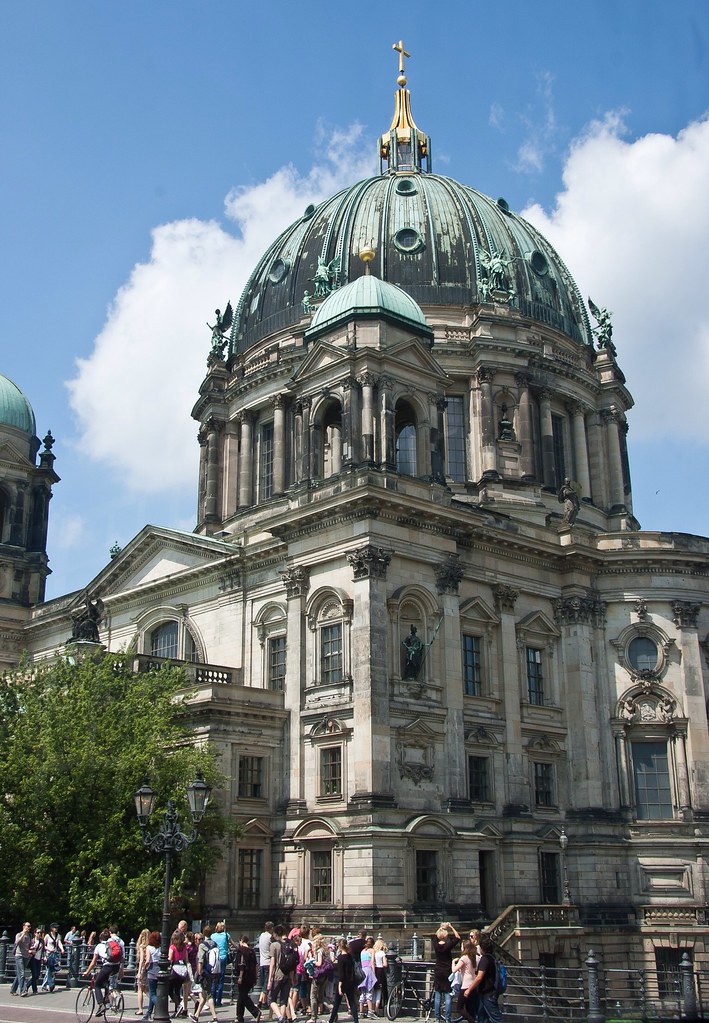
Above: Berlin Cathedral.
Our final visit was a brief photo stop at Charlottenburg Palace, the largest palace in Berlin, and the only surviving royal residence in the city. dating back to the time of the Hohenzollern family. The palace was built at the end of the 17th century and was greatly expanded during the 18th century. It includes much exotic internal decoration in baroque and rococo styles. During the Second World War, the palace was badly damaged but has since been reconstructed.

Above: Charlottenburg Palace.

Above: A statue of Friedrich Wilhelm I, elector of Brandenburg at the front of the Palace.
I hope you enjoyed this very brief glimpse of Berlin. I'm looking forward to showing you some more amazing Baltic (and Mediterranean) ports soon!

No comments:
Post a Comment